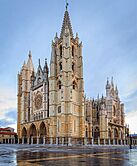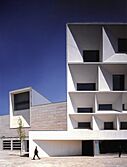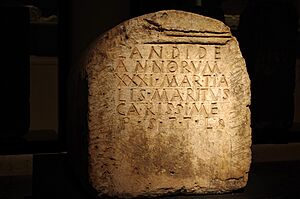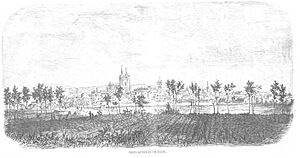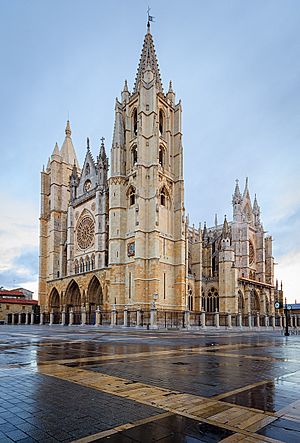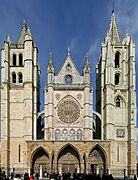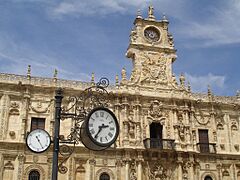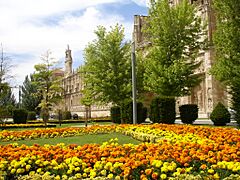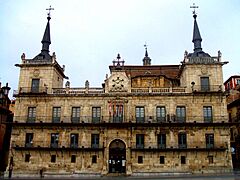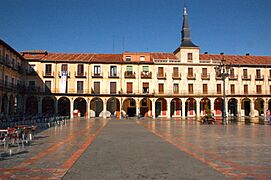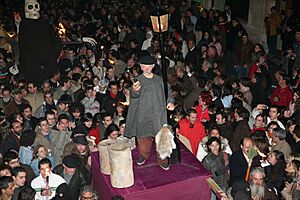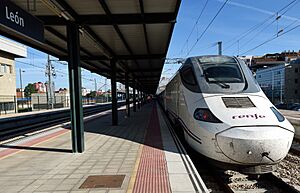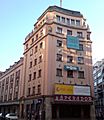León, Spain facts for kids
Quick facts for kids
León
Llión
|
|||
|---|---|---|---|
|
|
|||
|
|||
| Anthem: Himno a León | |||
| Country | Spain | ||
| Autonomous community | Castile and León | ||
| Province | León | ||
| Founded | 1st century BC | ||
| Founded by | Legio VI Victrix | ||
| Government | |||
| • Type | Ayuntamiento | ||
| • Body | Ayuntamiento de León | ||
| Area | |||
| • Land | 39.03 km2 (15.07 sq mi) | ||
| Elevation | 837 m (2,746 ft) | ||
| Population
(2018)
|
|||
| • Municipality | 124,772 | ||
| • Metro | 202,793 | ||
| Demonym(s) | Leonese Leonés/leonesa or Legionense (Spanish) Llïonés (Leonese) |
||
| Time zone | UTC+1 (CET) | ||
| • Summer (DST) | UTC+2 (CEST) | ||
| Postal code |
24001 - 24010
|
||
| Telephone prefix | 987 | ||
| Website | Ayuntamiento de León | ||
León is a historic city and municipality in Spain. It is the capital of the province of León, located in the northwest of the Iberian Peninsula. The city is part of the Castile and León region. About 124,000 people live in León, making it the largest city in its province. If you include nearby towns, the population of the wider area is around 200,000.
León was first built as a Roman military camp around 29 BC. It became an important city when the Legio VII Gemina army settled there in 74 AD. After a period of decline, León became the capital of the Kingdom of León in 910. This kingdom played a big role in the Reconquista, which was the Christian effort to take back Spain from the Moors.
In 1188, León hosted the first Parliament meeting in European history. This happened under the rule of Alfonso IX of León. Because of this, León is known as the "cradle of Parliamentarism". In 2013, UNESCO recognized the old laws from León (called the Decreta of León) as part of the Memory of the World register. The city's importance lessened after the Kingdom of León joined with the Crown of Castile in 1301.
After a quiet period, León was one of the first cities to rise up during the Spanish War of Independence. Later, in 1833, it became a provincial capital. In the late 1800s and 1900s, León grew quickly. It became a key transport hub because of the coal mining industry and the arrival of the railroad.
Today, León is famous for its history, beautiful buildings, and many festivals, especially the Easter processions. It is also a stop on the French Way of the Camino de Santiago, a famous pilgrimage route and a UNESCO World Heritage Site. This makes León a popular place for both Spanish and international visitors.
Contents
León's Rich History
How León Began: Roman Times
León was founded in the 1st century BC by a Roman legion called Legio VI Victrix. This army served under Caesar Augustus during the Cantabrian Wars. These wars were the final part of the Roman conquest of Spain. In 74 AD, another Roman army, the Legio VII Gemina, set up a permanent camp here. This camp became the city we know today. The name León comes from the Latin words Castra Legionis, meaning "camp of the legion."
The Romans built the city to protect their newly conquered lands in northwest Spain. They also wanted to keep the gold safe as it was transported from nearby mines like Las Médulas to Rome.
Parts of the original Roman camp can still be seen in León today. Long sections of the Roman walls, built between the 1st and 4th centuries AD, are still standing. You can also find archaeological exhibits showing parts of the walls, gates, baths, and an amphitheater.
León in the Middle Ages
After the Roman Empire, León's story is mostly about the Kingdom of León. The city grew from the Roman army camp and resisted attacks from the Visigoths until 586 AD. It was one of the few cities the Visigoths allowed to keep its strong walls.
Around 715 AD, during the Umayyad conquest of Hispania, Muslim forces reached León. Later, around 846 AD, a group of Mozarabs (Christians living under Muslim rule) tried to rebuild the city. However, a Muslim attack stopped them. In 856 AD, under the Christian king Ordoño I, another attempt to repopulate the city was successful. Alfonso III of León and García I of León made León the capital of the Kingdom of León. It became the most important Christian city in Spain.
The capital of the Kingdom of Asturias moved to León in 910.
In 987, the city was attacked by Almanzor. But it was rebuilt and repopulated by Alfonso V of León. His laws in 1017 helped the city's economy, including its markets. León was an important stop for pilgrims on the Camino de Santiago, a route leading to Santiago de Compostela.
In 1188, Alfonso IX of León brought together important groups in the city. These included representatives from the towns. This meeting, known as the Cortes of León of 1188, is recognized by UNESCO as the "cradle" of parliamentarism.
New areas for traders and craftspeople grew around the city. These groups started to have more say in the city's government after the 13th century. During the early Middle Ages, the livestock industry brought wealth to León.
Modern History of León
In the 1500s, León's economy and population started to shrink. This continued until the 1800s. During this time, a few noble families controlled the city.
The city's population grew from 9,000 to 15,000 during the 1800s. It grew even more in the 1900s: 18,000 in 1910, 44,000 in 1940, 73,000 in 1960, and 100,000 in 1971.
In 1936, a military uprising started in León, marking the beginning of the Spanish Civil War. The city quickly came under the control of the rebel forces. The Catholic Church supported the rebels. The rebels then took control of the rest of the province. During this time, places like the Convento de San Marcos and the provincial prison were used as large detention centers.
In the 1960s, León grew a lot as people moved from the countryside into the city.
Must-See Sights in León
Churches and Religious Buildings
- León Cathedral: This is a stunning example of Gothic architecture in Spain. Most of it was built between 1205 and 1301. It has one of the largest and best-preserved collections of medieval stained glass in Europe. There are at least 1,764 square meters of stained glass, and most of it is original.
- Basilica of San Isidoro: This is a top example of Romanesque architecture in Spain. It was built in the 11th and 12th centuries. The complex includes a Royal Pantheon underground with amazing 12th-century painted murals that are still in great condition.
- Convent of San Marcos: This building, constructed from the 16th to 18th centuries, is now a fancy hotel. Its most striking part is its very decorated plateresque style front.
- Church of San Salvador de Palat del Rey: This is the oldest church in the city, from the 10th century. Not much of the original building remains. It used to be a royal chapel.
- Church of Nuestra Señora del Mercado: This church dates back to the 11th century.
- Church of San Francisco: This is an active Catholic church finished in 1791.
- Church of San Juan y San Pedro de Renueva: Built between 1944 and 1970, it has an 18th-century Baroque front from a ruined monastery outside the city.
Other Historic Buildings
- Roman Walls: These walls were built in the 1st century BC and made bigger in the 3rd and 4th centuries AD. Long parts of the walls on the east and north sides are still standing. You can also see smaller parts on the west and south sides. Some sections of a Medieval wall from the 13th and 14th centuries also exist. You can visit parts of the wall.
- Casa Botines: This neogothic style building was designed by the famous architect Antoni Gaudí. It was built in 1891-1892. It is one of only three Gaudí buildings outside of Catalonia.
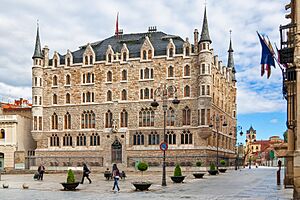
- Palacio de los Guzmanes: This building is home to the provincial parliament. It has a beautiful courtyard in the plateresque style.
- Palacio del Conde Luna: This palace dates back to the 14th century.
- Palacio de los Marqueses de Prado: A 17th-century Baroque building, now a hospital.
Museums to Explore
- MUSAC: This is a contemporary art museum that opened in 2005. Its unique design, with thousands of colorful stained-glass panels on its front, won an award in 2007.
- Museo de León: This museum has a collection of ancient tools and art from Roman, Medieval, and modern times.
- Museo Sierra-Pambley: A house from the Age of Enlightenment that is now a museum.
Other Interesting Places
- Plaza Mayor: This is the main square of the city.
- Plaza del Grano: Another charming square.
- Barrio Húmedo: This is a lively area known for its many bars and restaurants.
- University of León: The city's university.
-
León Cathedral, main facade
Fun Festivals and Traditions
León has many special traditions. One of the most famous is Semana Santa ("Holy Week"). During this week, many processions take place through the city center. One special procession is "The Procession of the Meeting," which shows three groups meeting: Saint John, the Virgin Mary, and Christ. Another unique procession is "The Burial of Genarín," which is a funny parade remembering a furrier who died in 1929.
The San Juan and San Pedro festivities are also very popular. They happen during the last week of June. During these days, there are concerts and festivals. The city fills with outdoor seating and street markets. People celebrate the start of summer, especially on San Juan's night (June 23), with fireworks and bonfires.
City Districts
León is divided into more than 36 districts, called barrios:
- Centro or downtown
- Casco Antiguo or Casco Histórico (the historical part)
- Área 17
- Armunia
- Cruce de Armunia
- El Crucero
- El Ejido
- Ensanche
- Eras De Renueva
- Ferral
- La Asunción
- La Chantría
- La Lastra
- La Palomera
- La Sal
- La Torre
- La Vega
- La Victoria
- Las Ventas
- Obra Sindical Del Hogar
- Oteruelo De La Valdoncina
- Paraíso-Cantinas
- Patronato Viviendas Militares
- Pinilla
- Puente Castro
- San Andrés del Rabanedo
- San Claudio
- San Esteban
- San Lorenzo
- San Mamés
- San Marcelo
- San Marcos
- San Martín
- San Pedro
- Santa Ana
- Santa Marina
- Santa Olaja
- Polígono 10
- Trobajo Del Cerecedo
- Trobajo Del Camino
- Villabalter
León's Climate
León has a climate that feels like an oceanic climate or a warm-summer Mediterranean climate. In winter, temperatures are usually between -1°C and 13°C. Frost is common in the mornings during the coldest days, but it usually melts after the sun rises. Snow falls about 9 days a year, but heavy snow is not common. Summers are warm and quite dry, with temperatures usually between 16°C and 35°C. The city gets a good amount of sunshine throughout the year, with about 2,673 hours of sun.
| Climate data for León, Virgen del Camino 916 m asl (1991–2020), extremes (1938-present) | |||||||||||||
|---|---|---|---|---|---|---|---|---|---|---|---|---|---|
| Month | Jan | Feb | Mar | Apr | May | Jun | Jul | Aug | Sep | Oct | Nov | Dec | Year |
| Record high °C (°F) | 21.0 (69.8) |
20.9 (69.6) |
25.5 (77.9) |
29.2 (84.6) |
31.9 (89.4) |
36.5 (97.7) |
38.2 (100.8) |
38.2 (100.8) |
37.4 (99.3) |
30.5 (86.9) |
23.4 (74.1) |
19.0 (66.2) |
38.2 (100.8) |
| Mean daily maximum °C (°F) | 7.3 (45.1) |
9.8 (49.6) |
13.4 (56.1) |
15.4 (59.7) |
19.4 (66.9) |
24.4 (75.9) |
27.5 (81.5) |
27.1 (80.8) |
22.9 (73.2) |
17.1 (62.8) |
11.2 (52.2) |
8.2 (46.8) |
17.0 (62.6) |
| Daily mean °C (°F) | 3.3 (37.9) |
4.8 (40.6) |
7.6 (45.7) |
9.5 (49.1) |
13.0 (55.4) |
17.3 (63.1) |
19.8 (67.6) |
19.7 (67.5) |
16.4 (61.5) |
11.9 (53.4) |
7.0 (44.6) |
4.2 (39.6) |
11.3 (52.3) |
| Mean daily minimum °C (°F) | −0.7 (30.7) |
−0.2 (31.6) |
1.9 (35.4) |
3.6 (38.5) |
6.7 (44.1) |
10.2 (50.4) |
12.1 (53.8) |
12.2 (54.0) |
9.8 (49.6) |
6.8 (44.2) |
2.7 (36.9) |
0.3 (32.5) |
5.5 (41.9) |
| Record low °C (°F) | −17.4 (0.7) |
−14.4 (6.1) |
−11.2 (11.8) |
−6.1 (21.0) |
−4.0 (24.8) |
0.0 (32.0) |
3.0 (37.4) |
2.6 (36.7) |
0.0 (32.0) |
−3.4 (25.9) |
−7.2 (19.0) |
−15.4 (4.3) |
−17.4 (0.7) |
| Average precipitation mm (inches) | 51.9 (2.04) |
31.9 (1.26) |
39.9 (1.57) |
47.9 (1.89) |
55.5 (2.19) |
29.5 (1.16) |
18.1 (0.71) |
20.3 (0.80) |
30.6 (1.20) |
63.4 (2.50) |
55.6 (2.19) |
58.1 (2.29) |
502.7 (19.8) |
| Average precipitation days (≥ 1 mm) | 8.5 | 5.9 | 7.0 | 8.2 | 8.3 | 4.4 | 2.9 | 2.7 | 4.5 | 8.4 | 8.1 | 7.9 | 76.8 |
| Mean monthly sunshine hours | 131 | 173 | 219 | 239 | 277 | 324 | 365 | 333 | 259 | 187 | 142 | 125 | 2,774 |
| Source: Météo Climat | |||||||||||||
| Climate data for León, Virgen del Camino 916 m asl (1981-2010) | |||||||||||||
|---|---|---|---|---|---|---|---|---|---|---|---|---|---|
| Month | Jan | Feb | Mar | Apr | May | Jun | Jul | Aug | Sep | Oct | Nov | Dec | Year |
| Record high °C (°F) | 21.0 (69.8) |
21.5 (70.7) |
25.5 (77.9) |
29.2 (84.6) |
31.9 (89.4) |
36.5 (97.7) |
36.5 (97.7) |
38.2 (100.8) |
37.4 (99.3) |
28.4 (83.1) |
23.4 (74.1) |
19.0 (66.2) |
38.2 (100.8) |
| Mean daily maximum °C (°F) | 7.1 (44.8) |
9.5 (49.1) |
13.3 (55.9) |
14.8 (58.6) |
18.6 (65.5) |
24.0 (75.2) |
27.4 (81.3) |
26.9 (80.4) |
22.9 (73.2) |
16.7 (62.1) |
11.2 (52.2) |
8.0 (46.4) |
16.7 (62.1) |
| Daily mean °C (°F) | 3.2 (37.8) |
4.7 (40.5) |
7.6 (45.7) |
9.0 (48.2) |
12.6 (54.7) |
17.1 (62.8) |
19.8 (67.6) |
19.6 (67.3) |
16.5 (61.7) |
11.7 (53.1) |
7.0 (44.6) |
4.3 (39.7) |
11.1 (52.0) |
| Mean daily minimum °C (°F) | −0.7 (30.7) |
0.0 (32.0) |
1.9 (35.4) |
3.3 (37.9) |
6.6 (43.9) |
10.2 (50.4) |
12.2 (54.0) |
12.3 (54.1) |
10.1 (50.2) |
6.7 (44.1) |
2.8 (37.0) |
0.4 (32.7) |
5.5 (41.9) |
| Record low °C (°F) | −17.4 (0.7) |
−14.4 (6.1) |
−11.2 (11.8) |
−6.1 (21.0) |
−4.0 (24.8) |
0.0 (32.0) |
3.0 (37.4) |
2.6 (36.7) |
0.0 (32.0) |
−3.4 (25.9) |
−7.2 (19.0) |
−15.4 (4.3) |
−17.4 (0.7) |
| Average precipitation mm (inches) | 50 (2.0) |
34 (1.3) |
32 (1.3) |
45 (1.8) |
56 (2.2) |
31 (1.2) |
19 (0.7) |
23 (0.9) |
39 (1.5) |
61 (2.4) |
59 (2.3) |
66 (2.6) |
515 (20.3) |
| Average precipitation days | 8 | 6 | 6 | 8 | 9 | 5 | 3 | 3 | 5 | 8 | 8 | 9 | 75 |
| Average snowy days | 4 | 3 | 2 | 1 | 0 | 0 | 0 | 0 | 0 | 0 | 1 | 2 | 13 |
| Average relative humidity (%) | 82 | 74 | 66 | 65 | 62 | 56 | 52 | 54 | 62 | 74 | 80 | 83 | 67 |
| Mean monthly sunshine hours | 130 | 161 | 214 | 228 | 259 | 314 | 358 | 327 | 246 | 178 | 137 | 120 | 2,673 |
| Source: Agencia Estatal de Meteorología | |||||||||||||
Getting Around León
León Airport
León Airport (LEN) is about 6 kilometres from the city center. It is located in the nearby town of La Virgen del Camino. The airport mainly offers flights within Spain. Two Spanish airlines, Iberia/Air Nostrum and Air Europa, fly from here. Air Nostrum has flights to Barcelona, Spain. During the summer, more destinations are available, including Palma de Mallorca, Tenerife, Ibiza, Menorca, Málaga, and Gran Canaria.
Railway Stations
León has two train stations. The main one is León railway station for Renfe trains. The other is León-Matallana for Renfe Feve lines. High-speed trains connect León to Madrid in about two hours. You can also travel directly from León to Galicia (west), Asturias (north), and Valladolid (southeast).
Public Transport
León has 13 city bus lines, run by a company called Alesa. There are also plans to add tram lines in the city in the future.
The Leonese Language
History of Leonese Language
The Leonese language comes directly from Latin. It developed during the Middle Ages. Back then, Leonese was the official language of the Kingdom of León. It was very well-developed in the city of León. The first known text written in Leonese is Nodicia de Kesos (from 959 or 974). Other important works in the language include Fueru de Llión and Disputa d'Elena y María.
Today, UNESCO considers Leonese a seriously endangered language. Only a few elderly people in the mountains of northern León still speak it. However, some groups are working to bring the language back. The León City Council and Leonese language groups are promoting its learning and use.
Leonese Language Day started in 2006. Since 2008, the León City Council has organized this celebration.
Learning Leonese
In the late 1990s, several groups started unofficial Leonese language classes. In 2001, the University of León began a course for teachers of Leonese. The local government also created Leonese language courses for adults. The Leonese Language Teachers and Monitors Association was formed in 2008 to promote activities related to the language.
Leonese lessons began in schools in 2008. In 2008–2009, sixteen schools in León city taught the language. This course is for students in their 5th and 6th year of primary school (around 11-12 years old). They learn both the Leonese language and its culture.
More than one hundred adults were studying Leonese in official classes in 2008–2009. There are five levels for adults offered by the Leonese City Council.
León's Sister Cities
León is connected with these cities around the world:
 Bragança, Portugal
Bragança, Portugal Porto, Portugal
Porto, Portugal León (Guanajuato), México
León (Guanajuato), México Voronezh, Russia
Voronezh, Russia Dublin, Ireland
Dublin, Ireland Xiangtan, China
Xiangtan, China Córdoba (Spain)
Córdoba (Spain) Chartres
Chartres
Delicious Food in León

León has many tasty traditional dishes. Some of the most famous are:
- Cecina: This is cured, smoked beef.
- Morcilla: A type of blood sausage.
- Botillo: A dish made of meat-stuffed pork intestine.
- Garlic soup.
- El cocido leonés: A hearty meal with meat, vegetables, and chickpeas, often served after a vegetable and noodle soup.
- Mantecadas: A type of pastry.
Another very important part of León's food culture is tapas. These are small snacks usually given for free when you order a drink. It's very common to go "de tapas" or "tapear." This means going out for a few drinks, like a small beer ("un corto" or "una caña") or a glass of wine ("un vino"), and enjoying the free snacks. People often do this before lunch or as a light dinner.
Famous People from León
- Buenaventura Durruti (1896–1936), an important anarchist leader.
- Mario Amilivia (born 1957), a former mayor.
- Miguel Castaño (1883-1936), the first mayor elected by the people.
- Moisés de León (1240-1305), a rabbi and writer.
- Dolores Gortázar Serantes (1872-1936), a novelist.
- Carlos Dominguez Cidon (1959-2009), a chef and author.
- José Luis Rodríguez Zapatero (1960-), who was the prime minister of Spain from 2004 to 2011.
- Manuel Martínez (1974-), a retired shot putter with many Spanish records.
- Carolina Rodríguez (1986-), a rhythmic gymnast who competed in three Olympic Games.
- Sara Llana (born 1997), a rhythmic gymnast and member of Spain's national team.
- David Vidales (born 2002), a racing driver.
- Emilio Zapico (1944–1996), a racing driver.
Images for kids
-
Facade of Convento de San Marcos.
-
Principal façade of the Real Basílica de San Isidoro.
-
Panteón de los Reyes of Real Basílica de San Isidoro.
See also
 In Spanish: León (España) para niños
In Spanish: León (España) para niños


